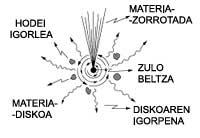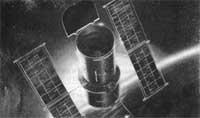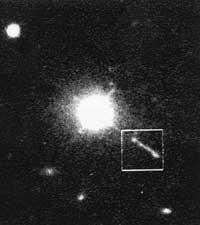Oven 3C273
1992/12/01 Arregi Bengoa, Jesus Iturria: Elhuyar aldizkaria
Next year will be 30 years since the kuasareas were considered extragalactic objects and began to be known by this name. The study of the radio source 3C273 was the one that gave rise to these conclusions, although no particularity was seen when it was considered first star and later as a radio source. The 3C273 label derives from being object 273 of catalog 3 of sources observed with the Cambridge radio telescope. This listing ended in 1959, but by then I had already seen 3C273 with optical telescopes, along with other stars from the Virgo constellation. For astronomers it was a normal star of magnitude 13 without any distinction. If we take into account that with a medium telescope at a glance we can see objects up to 6th magnitude, it can be said that it looks quite discreet.
The deep study of this star began in 1962, when the collaborators of Cyril Hazard and the University of Sidney discovered that that star of the constellation of Virgo and the source of radio 3C273 were in the same position in the firmament. They used the coating technique of the stars affected by the Moon, since the accuracy of the coordinates given in the Cambridge catalogue was insufficient. Given that the Moon had to cover the 3C273 tap three times within a few months, the team of researchers measured the duration of these covers. The position of the edge of the Moon can be measured very well, so those of the radio source were also calculated with great precision. Moreover, it was verified that the source had two foci and the coordinates of both were calculated. The following optical identification was simple: one of the two foci was in the same place as the star mentioned.

The next step was to analyze the radio star. It is then that unforeseen events begin to emerge. At first it was thought that both 3C273 and other radio sources optically identified at the same time were stars, but their spectrum was totally unknown, totally different from what the stars show in the different steps of their evolution. However, in early 1963, Schmidt de Maart found an explanation for this spectrum, accepting a huge red slip of emission lines. This slippage was considered as a consequence of the radial velocity of distance from the object, that is, from the Doppler effect, discarding other interpretations such as gravitational effects. M. Considering the slide measured by Schmidt, the distance speed of the 3C273 object should be 44.700 km/s.
As is known, the Universe is expanding and the speed of propagation or estrangement of the stars is proportional to the distance, being the constant Hubble of proportionality. Its value has not been completely determined to date, but if we consider that as usual it ranges between 20 km/s and 30 km/s, the distance to the object 3C273 ranges from 2,000 to 3,000 million light years. Almost simultaneously J. Greenstein and T. A. Mr. Mattews studied the spectrum of the 3C48 object, reaching similar conclusions. In this case the distance speed was much higher, around 110,000 km/s. Therefore, the distance to the object is also more than twice the distance to 3C273. The most detailed optical observation made after obtaining these results confirmed that the morphology of the aforementioned stars is not the one shown by the stars as a whole. On the one hand, 3C273 has imputation of matter. 3C48 has a diffuse appearance.
Given all the reasons we have mentioned, it could be said without a doubt that these objects were not stars, but other extragalactic objects. Due to their character as radio stations and their undeniable stellar resemblance, they began to be called cuasare (short for quasi stellar radio sourde). However, professionals usually name them with the acronym QSO (quasi stellar object).
Currently more than three thousand cuasars are known. Although the former were found thanks to their radio broadcast, not all have emissions to detect. On the other hand, in terms of propagation speed, higher speeds have been found than you could imagine. For example, the sliding speed of the PC1158 + +4658 Network in the constellation of Ursa Mayor is 94% of that of light, which makes the distance to us between 9,000 and 14,000 million light years, depending on the value we take for the Hubble constant. That is, it is believed that the first galaxies began to form somewhat before this time in study; about 10 million years after the Big-Bang.
So far we have only talked about the speeds and distances of the tanks. However, only knowing this last magnitude is enough to reach a first important conclusion, corresponding to the enormous emission force of the quasars. How can his light reach us? If we are associated with the case of the 3C273 Network, taking into account the distance and intensity of emission that reaches us in all fields of the spectrum, it is estimated that the brightness of this Network must be 1014 times that of the Sun. If we consider that our galaxy is composed of approximately 100 billion (1011) stars similar to the average of the Sun, the brightness of the 3C273 cube is 1000 times that of a normal galaxy.
The study of spectral emission lines allows estimating the mass of the quasi nucleus. Some of the cuasar emission lines are more agile than those obtained in the laboratory. This extension is representative of the movement of the source cloud of the emission. Due to the rotation movement, the measurement of the width of the lines allows to calculate the speed of the cloud. It is logical to consider that the movement of the cloud is due to the force of gravity generated by the mass of the cloud core. Thus, the speed of the cloud will inform us of the force and, ultimately, of the motive mass.
Let's look at the results we get by applying this to 3C273. Suppose a cloud moving at 5,000 km/s. If the distance from the cloud to the center of the cloud was 10 light years (completely measured because this measurement has not yet been obtained), the mass of the nucleus of 3C273 would be 2,000 million times greater than that of the Sun, 500 times less than that of a normal galaxy.
It seems contradictory that, being the mass of the quasi-minor, the energy is so many times greater. The key to the problem lies in the reduction of the accumulation volume of this mass. Cuasars usually have large variations of brightness. The time required to carry out these changes provides us with information about the size of the issuing region. Let's see why. In order for the increase of brightness to be representative at a given time, the process of generating energy must be simple throughout the region, but for this it must be within limited distances.
Otherwise, the time it takes for the process to expand into space will be extended and the increase in brightness will occur at a higher speed. Since the maximum propagation speed of any process is that of light, we can say that the temporal scale of any change (for example, one year) provides us with the spatial scale of the region that has produced the change (in the same example, one year of light). That is, if the process expands by the speed of light, the increase in brightness occurs at a distance of one year, but the brightness increases for one year.
Studies on 3C273 have shown that changes are frequent. The time scales of these changes are different, but almost all of them exceed 10 days and quite inferior to the year. Therefore, the region generating the energy emission is of little light of month. In it, therefore, the fifth part of the mass of our galaxy accumulates, with a thousand brightness greater than that of our galaxy.
The figure of the cuaseras that we have just presented, has associated a new question. What process can generate so much energy in such a small space? In the next issue we will try to answer this question.
Let's finish, summing up. All research points to quasars as nuclei of hyperactive galaxies. As this activity develops in the nucleus, we only see it, and the environment is only perceived through a thin luminosity.
Ephemeris SUN: Winter begins on December 21. 14 h 43 min. (UT) The Sun enters Capricorn. MOONS
h 17 min 923 h 41 min 1619 h 13 min 240 h 43 min PLANETS
|

Gai honi buruzko eduki gehiago
Elhuyarrek garatutako teknologia





